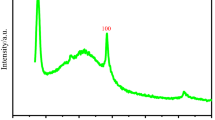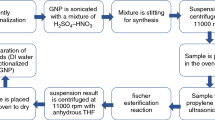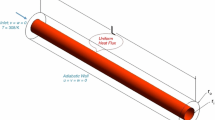Abstract
Heat transfer rate and amount of pressure drop for highly stabled nanofluids loaded with polyvinyl alcohol-treated graphene oxide (PVA-GO) were experimentally investigated in a horizontal copper duct with the uniform heat flux on outer surface of test section. To meet those goals, we produced GO through a wet-based exfoliation method and followed by functionalization of GO with PVA. As a phase of study, some nanofluids including PVA-GO with different concentration were prepared and thermo-physical and rheological properties were experimentally obtained. The thermo-physical attributes such as thermal conductivity, viscosity and density of the synthesized samples with various PVA-GO concentrations (0.025, 0.05, and 0.1 mass%) were experimentally investigated at the first phase of this article. Possessing the thermo-physical properties open a precise gate to measure the heat transfer rate (h & Nu) and frication factor for water/PVA-GO nanofluids and finally compared with the working fluid (water). As the second phase of study, influence of parameters such as concentration of PVA-GO and the flow rate on heat transfer parameters such as Nu, friction factor, and performance index were investigated. Overall, processing heat transfer systems with highly conductive water/PVA-GO nanofluids even at low concentrations results in higher heat transfer rate and overall performance of system/cycles.










Similar content being viewed by others
Abbreviations
- C p :
-
Specific heat (J g−1 k−1)
- D :
-
Diameter (m)
- h :
-
Heat transfer coefficient (W m−2 k−1)
- k :
-
Thermal conductivity (W m−1 k−1)
- Nu:
-
Nusselt number
- q :
-
Heat flux (W m−2)
- Q :
-
Heat transfer rate (W)
- Re:
-
Reynolds number
- U ave :
-
Average velocity (m s−1)
- f :
-
Friction factor
- m o :
-
Mass flow rate (kg s−1)
- L :
-
Channel length (m)
- L x/L :
-
Ratio of the length of x to the channel length
- T sx :
-
The wall temperature of the fluid at the axial distance x
- T bx :
-
The bulk temperature of the fluid at the axial distance x
- A w :
-
Area of the downstream wall (m2)
- PI:
-
Performance index
- RTD:
-
Resistance temperature detector
- μ :
-
Viscosity (Pa s)
- ρ :
-
Density (kg m−3)
- ΔP :
-
Pressure drop (Pa)
- nf:
-
Nanofluid
- bf:
-
Base fluid
- ave:
-
Average
- s:
-
Tube wall
- In:
-
Inlet
- out:
-
Outlet
References
Kralova I, Sjöblom J. Biofuels-renewable energy sources: a review. J Dispersion Sci Technol. 2010;31(3):409–25. https://doi.org/10.1080/01932690903119674.
Graillat C, Lepais-Masmejean M, Pichot C. Stabilization optimization of aqueous monomer solutions in oil emulsions using the cohesive energy ratio concept. J Dispersion Sci Technol. 1990;11(5):455–77. https://doi.org/10.1080/01932699008943271.
Shanbedi M, Heris SZ, Amiri A, Adyani S, Alizadeh M, Baniadam M. Optimization of the thermal efficiency of a two-phase closed thermosyphon using active learning on the human algorithm interaction. Numer Heat Transfer Part A. 2014;66(8):947–62. https://doi.org/10.1080/10407782.2014.892388.
Shanbedi M, Zeinali Heris S, Maskooki A, Eshghi H. Statistical analysis of laminar convective heat transfer of MWCNT-deionized water nanofluid using the response surface methodology. Numer Heat Transfer. 2015;68(4):454–69. https://doi.org/10.1080/10407782.2014.986003.
Qiu L, Ouyang Y, Feng Y, Zhang X. Review on micro/nano phase change materials for solar thermal applications. Renew Energy. 2019;140:513–38. https://doi.org/10.1016/j.renene.2019.03.088.
Qiu L, Zhu N, Feng Y, Michaelides EE, Żyła G, Jing D et al. A review of recent advances in thermophysical properties at the nanoscale: from solid state to colloids. Phys Rep. 2020;843:1–81.
Sivasamy P, Devaraju A, Harikrishnan S. Review on heat transfer enhancement of phase change materials (PCMs). Mater Today. 2018;5(6):14423–31.
Amiri A, Shanbedi M, Ahmadi G, Rozali S. Transformer oils-based graphene quantum dots nanofluid as a new generation of highly conductive and stable coolant. Int Commun Heat Mass Transfer. 2017;83:40–7.
Amiri A, Shanbedi M, Dashti H. Thermophysical and rheological properties of water-based graphene quantum dots nanofluids. J Taiwan Inst Chem Eng. 2017;76:132–40.
Yu W, Xie H, Wang X. Enhanced thermal conductivity of liquid paraffin based nanofluids containing copper nanoparticles. J Dispersion Sci Technol. 2011;32(7):948–51. https://doi.org/10.1080/01932691.2010.488503.
Solanki JN, Murthy ZVP. Preparation of silver nanofluids with high electrical conductivity. J Dispersion Sci Technol. 2011;32(5):724–30. https://doi.org/10.1080/01932691.2010.480863.
Amiri A, Arzani HK, Kazi SN, Chew BT, Badarudin A. Backward-facing step heat transfer of the turbulent regime for functionalized graphene nanoplatelets based water–ethylene glycol nanofluids. Int J Heat Mass Tran. 2016;97:538–46.
Amiri A, Shanbedi M, AliAkbarzade MJ. The specific heat capacity, effective thermal conductivity, density, and viscosity of coolants containing carboxylic acid functionalized multi-walled carbon nanotubes. J Dispersion Sci Technol. 2016;37(7):949–55. https://doi.org/10.1080/01932691.2015.1074588.
Mohd Zubir MN, Badarudin A, Kazi SN, Nay Ming H, Sadri R, Amiri A. Investigation on the use of graphene oxide as novel surfactant for stabilizing carbon based materials. J Dispersion Sci Technol. 2016;37(10):1395–407. https://doi.org/10.1080/01932691.2015.1108850.
Amiri A, Shanbedi M, Ahmadi G, Rozali S. Transformer oils-based graphene quantum dots nanofluid as a new generation of highly conductive and stable coolant. Intl Commun Heat Mass Transf. 2017;83:40–7. https://doi.org/10.1016/j.icheatmasstransfer.2017.03.011.
Amiri A, Kazi SN, Shanbedi M, Mohd Zubir MN, Yarmand H, Chew BT. Transformer oil based multi-walled carbon nanotube-hexylamine coolant with optimized electrical, thermal and rheological enhancements. RSC Adv. 2015;5(130):107222–36. https://doi.org/10.1039/C5RA17687E.
Shanbedi M, Heris SZ, Amiri A, Hosseinipour E, Eshghi H, Kazi S. Synthesis of aspartic acid-treated multi-walled carbon nanotubes based water coolant and experimental investigation of thermal and hydrodynamic properties in circular tube. Energy Convers Manage. 2015;105:1366–76.
Amiri A, Shanbedi M, Chew B, Kazi S, Solangi K. Toward improved engine performance with crumpled nitrogen-doped graphene based water–ethylene glycol coolant. Chem Eng J. 2016;289:583–95.
Heris SZ, Shokrgozar M, Poorpharhang S, Shanbedi M, Noie SH. Experimental study of heat transfer of a car radiator with CuO/ethylene glycol-water as a coolant. J Dispersion Sci Technol. 2014;35(5):677–84. https://doi.org/10.1080/01932691.2013.805301.
Beheshti A, Shanbedi M, Heris SZ. Heat transfer and rheological properties of transformer oil-oxidized MWCNT nanofluid. J Therm Anal Calorim. 2014;118(3):1451–60. https://doi.org/10.1007/s10973-014-4048-0.
Solangi K, Kazi S, Luhur M, Badarudin A, Amiri A, Sadri R, et al. A comprehensive review of thermo-physical properties and convective heat transfer to nanofluids. Energy. 2015;89:1065–86.
Rayatzadeh HR, Saffar-Avval M, Mansourkiaei M, Abbassi A. Effects of continuous sonication on laminar convective heat transfer inside a tube using water–TiO2 nanofluid. Exp Thermal Fluid Sci. 2013;48:8–14. https://doi.org/10.1016/j.expthermflusci.2013.01.016.
Behzadmehr A, Saffar-Avval M, Galanis N. Prediction of turbulent forced convection of a nanofluid in a tube with uniform heat flux using a two phase approach. Int J Heat Fluid Flow. 2007;28(2):211–9. https://doi.org/10.1016/j.ijheatfluidflow.2006.04.006.
Yarmand H, Gharehkhani S, Shirazi SFS, Amiri A, Alehashem MS, Dahari M, et al. Experimental investigation of thermo-physical properties, convective heat transfer and pressure drop of functionalized graphene nanoplatelets aqueous nanofluid in a square heated pipe. Energy Convers Manage. 2016;114:38–49. https://doi.org/10.1016/j.enconman.2016.02.008.
Yarmand H, Gharehkhani S, Shirazi SFS, Goodarzi M, Amiri A, Sarsam WS, et al. Study of synthesis, stability and thermo-physical properties of graphene nanoplatelet/platinum hybrid nanofluid. Int Commun Heat Mass Transfer. 2016;77:15–211. https://doi.org/10.1016/j.icheatmasstransfer.2016.07.010.
Eastman JA, Choi S, Li S, Yu W, Thompson L. Anomalously increased effective thermal conductivities of ethylene glycol-based nanofluids containing copper nanoparticles. Appl Phys Lett. 2001;78(6):718–20.
Haddad Z, Oztop HF, Abu-Nada E, Mataoui A. A review on natural convective heat transfer of nanofluids. Renew Sustain Energy Rev. 2012;16(7):5363–78.
Amiri A, Ahmadi G, Shanbedi M, Etemadi M, Zubir MNM, Chew B, et al. Heat transfer enhancement of water-based highly crumpled few-layer graphene nanofluids. RSC Adv. 2016;6(107):105508–277.
Amiri A, Shanbedi M, Rafieerad A, Rashidi MM, Zaharinie T, Zubir MNM, et al. Functionalization and exfoliation of graphite into mono layer graphene for improved heat dissipation. J Taiwan Inst Chem Eng. 2016. https://doi.org/10.1016/j.jtice.2016.12.009.
King JA, Klimek DR, Miskioglu I, Odegard GM. Mechanical properties of graphene nanoplatelet/epoxy composites. J Appl Polym Sci. 2013;128(6):4217–23. https://doi.org/10.1002/app.38645.
Shazali SS, Amiri A, Mohd Zubir MN, Rozali S, Zabri MZ, Mohd Sabri MF, et al. Investigation of the thermophysical properties and stability performance of non-covalently functionalized graphene nanoplatelets with Pluronic P-123 in different solvents. Mater Chem Phys. 2018;206:94–102. https://doi.org/10.1016/j.matchemphys.2017.12.008.
Amiri A, Naraghi M, Ahmadi G, Soleymaniha M, Shanbedi M. A review on liquid-phase exfoliation for scalable production of pure graphene, wrinkled, crumpled and functionalized graphene and challenges. FlatChem. 2018;8:40–71. https://doi.org/10.1016/j.flatc.2018.03.004.
Amiri A, Ahmadi G, Shanbedi M, Savari M, Kazi S, Chew B. Microwave-assisted synthesis of highly-crumpled, few-layered graphene and nitrogen-doped graphene for use as high-performance electrodes in capacitive deionization. Sci Rep. 2015. https://doi.org/10.1038/srep17503.
Amiri A, Shanbedi M, Ahmadi G, Eshghi H, Kazi S, Chew B, et al. Mass production of highly-porous graphene for high-performance supercapacitors. Sci Rep. 2016;6:32686.
Ahmadi-Moghadam B, Sharafimasooleh M, Shadlou S, Taheri F. Effect of functionalization of graphene nanoplatelets on the mechanical response of graphene/epoxy composites. Mater Des. 2015;66:142–9. https://doi.org/10.1016/j.matdes.2014.10.047.
Strankowski M, Piszczyk L, Kosmela P, Korzeniewski P. Morphology and the physical and thermal properties of thermoplastic polyurethane reinforced with thermally reduced graphene oxide. Pol J Chem Technol. 2015;17(4):88–94. https://doi.org/10.1515/pjct-2015-0073.
Amiri A, Shanbedi M, Eshghi H, Heris SZ, Baniadam M. Highly dispersed multiwalled carbon nanotubes decorated with Ag nanoparticles in water and experimental investigation of the thermophysical properties. J Phys Chem C. 2012;116(5):3369–75.
Akhavan-Zanjani H, Saffar-Avval M, Mansourkiaei M, Ahadi M, Sharif F. Turbulent convective heat transfer and pressure drop of graphene-water nanofluid flowing inside a horizontal circular tube. J Dispersion Sci Technol. 2014;35(9):1230–40. https://doi.org/10.1080/01932691.2013.834423.
Sarsam WS, Amiri A, Kazi SN, Badarudin A. Stability and thermophysical properties of non-covalently functionalized graphene nanoplatelets nanofluids. Energy Convers Manage. 2016;116:101–11. https://doi.org/10.1016/j.enconman.2016.02.082.
Qiu L, Zou H, Wang X, Feng Y, Zhang X, Zhao J, et al. Enhancing the interfacial interaction of carbon nanotubes fibers by Au nanoparticles with improved performance of the electrical and thermal conductivity. Carbon. 2019;141:497–505.
Chen J, Yao B, Li C, Shi G. An improved Hummers method for eco-friendly synthesis of graphene oxide. Carbon. 2013;64:225–9.
Teng K, Amiri A, Kazi S, Bakar M, Chew B. Fouling mitigation on heat exchanger surfaces by EDTA-treated MWCNT-based water nanofluids. J Taiwan Inst Chem Eng. 2016;60:445–52.
Teng K, Amiri A, Kazi S, Bakar M, Chew B, Al-Shammaa A, et al. Retardation of heat exchanger surfaces mineral fouling by water-based diethylenetriamine pentaacetate-treated CNT nanofluids. Appl Thermal Eng. 2017;110:495–503.
Amiri A, Zubir MNM, Dimiev AM, Teng KH, Shanbedi M, Kazi SN, et al. Facile, environmentally friendly, cost effective and scalable production of few-layered graphene. Chem Eng J. 2017;326:1105–15. https://doi.org/10.1016/j.cej.2017.06.046.
Amiri A, Maghrebi M, Baniadam M, Heris SZ. One-pot, efficient functionalization of multi-walled carbon nanotubes with diamines by microwave method. Appl Surf Sci. 2011;257(23):10261–6.
Amiri A, Sadri R, Shanbedi M, Ahmadi G, Chew B, Kazi S, et al. Performance dependence of thermosyphon on the functionalization approaches: an experimental study on thermo-physical properties of graphene nanoplatelet-based water nanofluids. Energy Convers Manage. 2015;92:322–30.
Aravind SSJ, Baskar P, Baby TT, Sabareesh RK, Das S, Ramaprabhu S. Investigation of structural stability, dispersion, viscosity, and conductive heat transfer properties of functionalized carbon nanotube based nanofluids. J Phys Chem C. 2011;115(34):16737–44. https://doi.org/10.1021/jp201672p.
Samira P, Saeed Z, Motahare S, Mostafa K. Pressure drop and thermal performance of CuO/ethylene glycol (60%)-water (40%) nanofluid in car radiator. Korean J Chem Eng. 2014. https://doi.org/10.1007/s11814-014-0244-7.
Sarsam WS, Amiri A, Zubir MNM, Yarmand H, Kazi SN, Badarudin A. Stability and thermophysical properties of water-based nanofluids containing triethanolamine-treated graphene nanoplatelets with different specific surface areas. Colloids Surf A. 2016;500:17–311. https://doi.org/10.1016/j.colsurfa.2016.04.016.
Keblinski P, Phillpot S, Choi S, Eastman J. Mechanisms of heat flow in suspensions of nano-sized particles (nanofluids). Int J Heat Mass Transfer. 2002;45(4):855–63.
Eastman JA, Phillpot S, Choi S, Keblinski P. Thermal transport in nanofluids 1. Annu Rev Mater Res. 2004;34:219–46.
Shamaeil M, Firouzi M, Fakhar A. The effects of temperature and volume fraction on the thermal conductivity of functionalized DWCNTs/ethylene glycol nanofluid. J Therm Anal Calorim. 2016;126(3):1455–62. https://doi.org/10.1007/s10973-016-5548-x.
Zadkhast M, Toghraie D, Karimipour A. Developing a new correlation to estimate the thermal conductivity of MWCNT-CuO/water hybrid nanofluid via an experimental investigation. J Therm Anal Calorim. 2017;129(2):859–67. https://doi.org/10.1007/s10973-017-6213-8.
Toghraie D, Chaharsoghi VA, Afrand M. Measurement of thermal conductivity of ZnO–TiO2/EG hybrid nanofluid. J Therm Anal Calorim. 2016;125(1):527–35. https://doi.org/10.1007/s10973-016-5436-4.
Jbeili M, Wang G, Zhang J. Evaluation of thermal and power performances of nanofluid flows through square in-line cylinder arrays. J Therm Anal Calorim. 2017;129(3):1923–34. https://doi.org/10.1007/s10973-017-6363-8.
Hemmat Esfe M, Saedodin S. Turbulent forced convection heat transfer and thermophysical properties of Mgo–water nanofluid with consideration of different nanoparticles diameter, an empirical study. J Therm Anal Calorim. 2015;119(2):1205–13. https://doi.org/10.1007/s10973-014-4197-1.
Bashirnezhad K, Rashidi MM, Yang Z, Bazri S, Yan W-M. A comprehensive review of last experimental studies on thermal conductivity of nanofluids. J Therm Anal Calorim. 2015;122(2):863–84. https://doi.org/10.1007/s10973-015-4820-9.
Rajesh Kumar B, Shemeena Basheer N, Jacob S, Kurian A, George SD. Thermal-lens probing of the enhanced thermal diffusivity of gold nanofluid-ethylene glycol mixture. J Therm Anal Calorim. 2015;119(1):453–60. https://doi.org/10.1007/s10973-014-4208-2.
Leena M, Srinivasan S. A comparative study on thermal conductivity of TiO2/ethylene glycol–water and TiO2/propylene glycol–water nanofluids. J Therm Anal Calorim. 2017. https://doi.org/10.1007/s10973-017-6616-6.
Selvam C, Mohan Lal D, Harish S. Thermal conductivity and specific heat capacity of water–ethylene glycol mixture-based nanofluids with graphene nanoplatelets. J Therm Anal Calorim. 2017;129(2):947–55. https://doi.org/10.1007/s10973-017-6276-6.
Hemmat Esfe M, Behbahani PM, Arani AAA, Sarlak MR. Thermal conductivity enhancement of SiO2–MWCNT (85:15 %)–EG hybrid nanofluids. J Therm Anal Calorim. 2017;128(1):249–58. https://doi.org/10.1007/s10973-016-5893-9.
Lee G-J, Rhee CK. Enhanced thermal conductivity of nanofluids containing graphene nanoplatelets prepared by ultrasound irradiation. J Mater Sci. 2014;49(4):1506–11.
Ma W, Yang F, Shi J, Wang F, Zhang Z, Wang S. Silicone based nanofluids containing functionalized graphene nanosheets. Colloids Surf A. 2013;431:120–6.
Baby TT, Ramaprabhu S. Enhanced convective heat transfer using graphene dispersed nanofluids. Nanoscale Res Lett. 2011;6(1):1–9.
Baby TT, Sundara R. Synthesis and transport properties of metal oxide decorated graphene dispersed nanofluids. J Phys Chem C. 2011;115(17):8527–33.
Sun Z, Pöller S, Huang X, Guschin D, Taetz C, Ebbinghaus P, et al. High-yield exfoliation of graphite in acrylate polymers: a stable few-layer graphene nanofluid with enhanced thermal conductivity. Carbon. 2013;64:288–94.
Baby TT, Ramaprabhu S. Synthesis and nanofluid application of silver nanoparticles decorated graphene. J Mater Chem. 2011;21(26):9702–9. https://doi.org/10.1039/c0jm04106h.
Yu W, Xie H, Chen L, Li Y, Li D, editors. The Preparation and Thermal Conductivities Enhacement of Nanofluids Containing Graphene Oxide Nanosheets. 2010 14th International Heat Transfer Conference; 2010: American Society of Mechanical Engineers.
Amiri A, Ahmadi G, Shanbedi M, Etemadi M, Mohd Zubir MN, Chew BT, et al. Heat transfer enhancement of water-based highly crumpled few-layer graphene nanofluids. RSC Adv. 2016;6(107):105508–277. https://doi.org/10.1039/C6RA22365F.
Gupta SS, Siva VM, Krishnan S, Sreeprasad T, Singh PK, Pradeep T, et al. Thermal conductivity enhancement of nanofluids containing graphene nanosheets. J Appl Phys. 2011;110(8):084302.
Dhar P, Gupta SS, Chakraborty S, Pattamatta A, Das SK. The role of percolation and sheet dynamics during heat conduction in poly-dispersed graphene nanofluids. Appl Phys Lett. 2013;102(16):163114.
Xia ZY, Giambastiani G, Christodoulou C, Nardi MV, Koch N, Treossi E, et al. Synergic exfoliation of graphene with organic molecules and inorganic ions for the electrochemical production of flexible electrodes. ChemPlusChem. 2014;79(3):439–46.
Amiri A, Shanbedi M, Rafieerad AR, Rashidi MM, Zaharinie T, Zubir MNM, et al. Functionalization and exfoliation of graphite into mono layer graphene for improved heat dissipation. J Taiwan Inst Chem Eng. 2017;71:480–93. https://doi.org/10.1016/j.jtice.2016.12.009.
Park SS, Kim NJ. Influence of the oxidation treatment and the average particle diameter of graphene for thermal conductivity enhancement. J Ind Eng Chem. 2014;20(4):1911–5.
Liu J, Wang F, Zhang L, Fang X, Zhang Z. Thermodynamic properties and thermal stability of ionic liquid-based nanofluids containing graphene as advanced heat transfer fluids for medium-to-high-temperature applications. Renew Energy. 2014;63:519–23.
Solangi K, Amiri A, Luhur M, Ghavimi SAA, Kazi S, Badarudin A, et al. Experimental investigation of heat transfer performance and frictional loss of functionalized GNP-based water coolant in a closed conduit flow. RSC Adv. 2016;6(6):4552–633.
Samira P, Saeed ZH, Motahare S, Mostafa K. Pressure drop and thermal performance of CuO/ethylene glycol (60%)-water (40%) nanofluid in car radiator. Korean J Chem Eng. 2015;32(4):609–16.
Author information
Authors and Affiliations
Corresponding author
Additional information
Publisher's Note
Springer Nature remains neutral with regard to jurisdictional claims in published maps and institutional affiliations.
Rights and permissions
About this article
Cite this article
Azizi, M., Honarvar, B. Synthesis of highly stable nanofluids including polyvinyl alcohol-treated graphene oxide for improved heat dissipation in a tubular heat exchanger. J Therm Anal Calorim 145, 13–25 (2021). https://doi.org/10.1007/s10973-020-09677-w
Received:
Accepted:
Published:
Issue Date:
DOI: https://doi.org/10.1007/s10973-020-09677-w




